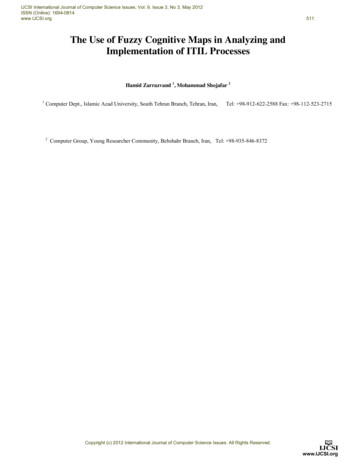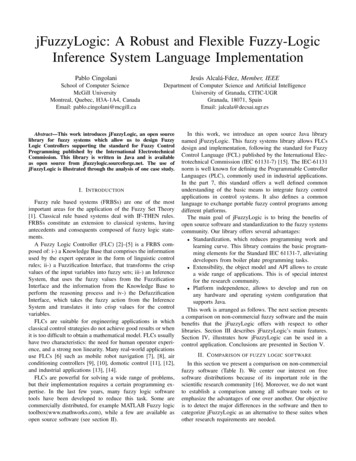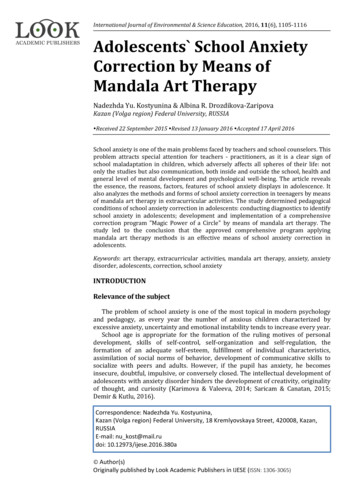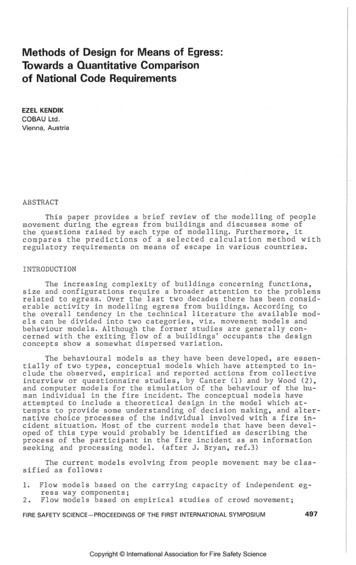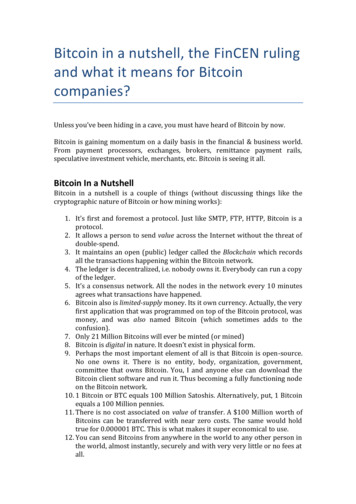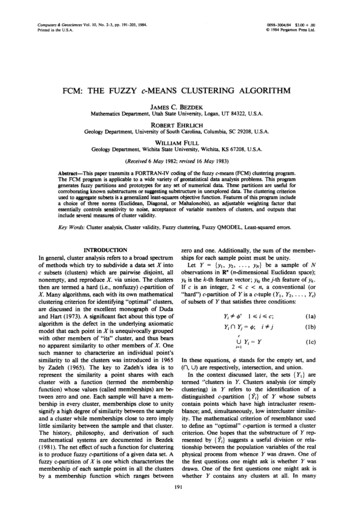
Transcription
Computers & Geosciences Vol. 10, No. 2-3, pp. 191-203, 1984.0098-3004/84 3.00 .00 1984 Pergamon Press Ltd.Printed in the U.S.A.FCM: THE FUZZY c-MEANS CLUSTERING ALGORITHMJAMES C. BEZDEKMathematics Department, Utah State University, Logan, UT 84322, U.S.A.ROBERT EHRLICHGeology Department, University of South Carolina, Columbia, SC 29208, U.S.A.WILLIAM FULLGeology Department, Wichita State University, Wichita, KS 67208, U.S.A.(Received 6 May 1982; revised 16 May 1983)AbstractnThis paper transmits a FORTRAN-IV coding of the fuzzy c-means (FCM) clustering program.The FCM program is applicable to a wide variety of geostatistical data analysis problems. This programgenerates fuzzy partitions and prototypes for any set of numerical data. These partitions are useful forcorroborating known substructures or suggesting substructure in unexplored data. The clustering criterionused to aggregate subsets is a generalized least-squares objective function. Features of this program includea choice of three norms (Euclidean, Diagonal, or Mahalonobis), an adjustable weighting factor thatessentially controls sensitivity to noise, acceptance of variable numbers of clusters, and outputs thatinclude several measures of cluster validity.Key Words: Cluster analysis, Cluster validity, Fuzzy clustering, Fuzzy QMODEL, Least-squared errors.INTRODUCTIONIn general, cluster analysis refers to a broad spectrumof methods which try to subdivide a data set X intoc subsets (clusters) which are pairwise disjoint, allnonempty, and reproduce X. via union. The clustersthen are termed a hard (i.e., nonfuzzy) c-partition ofX. Many algorithms, each with its own mathematicalclustering criterion for identifying "optimal" clusters,are discussed in the excellent monograph of Dudaand Hart (1973). A significant fact about this type ofalgorithm is the defect in the underlying axiomaticmodel that each point in X is unequivocally groupedwith other members of "its" cluster, and thus bearsno apparent similarity to other members of X. Onesuch manner to characterize an individual point'ssimilarity to all the clusters was introduced in 1965by Zadeh (1965). The key to Zadeh's idea is torepresent the similarity a point shares with eachcluster with a function (termed the membershipfunction) whose values (called memberships) are between zero and one. Each sample will have a membership in every cluster, memberships close to unitysignify a high degree of similarity between the sampleand a cluster while memberships close to zero implylittle similarity between the sample and that cluster.The history, philosophy, and derivation of suchmathematical systems are documented in Bezdek(1981). The net effect of such a function for clusteringis to produce fuzzy c-partitions of a given data set. Afuzzy c-partition of X is one which characterizes themembership of each sample point in all the clustersby a membership function which ranges betweenzero and one. Additionally, the sum of the memberships for each sample point must be unity.Let Y {Yl, Y2. . . . .y } be a sample of Nobservations in R n (n-dimensional Euclidean space);Yk is the k-th feature vector; Ykj the j-th feature of Yk.If C is an integer, 2 c n, a conventional (or"hard") c-partition of Y is a c-tuple (YI, Y2 . . . . . Yc)of subsets of Y that satisfies three conditions:Y '1 i c;(la)Y A Yj (a; i j(lb)cU Y, : Y(lc)i lIn these equations, stands for the empty set, and(n, u ) are respectively, intersection, and union.In the context discussed later, the sets { YI} aretermed "clusters in Y. Clusters analysis (or simplyclustering) in Y refers to the identification of adistinguished c-partition {Y } of Y whose subsetscontain points which have high intracluster resemblance; and, simultaneously, low intercluster similarity. The mathematical criterion of resemblance usedto define an "optimal" c-partion is termed a clustercriterion. One hopes that the substructure of Y represented by { I } suggests a useful division or relationship between the population variables of the realphysical process from whence Y was drawn. One ofthe first questions one might ask is whether Y wasdrawn. One of the first questions one might ask iswhether Y contains any clusters at all. In many191
192JAMES C. BEZDEK, ROBERTgeological analyses, a value for c is known a priorion physical grounds. If c is unknown, then determination of an optimal c becomes an important issue.This question is sometimes termed the "cluster validity" problem. Our discussion, in addition to theclustering a posteriori measures of duster validity (or"goodness of fit").Algorithms for clustering and cluster validity haveproliferated due to their promise for sorting outcomplex interactions between variables in high dimensional data. Excellent surveys of many popularmethods for conventional clustering using deterministic and statistical clustering criteria are available;for example, consult the books by Duda and Hart(1973), Tou and Gonzalez (1974), or Hartigan (1975).The conventional methodologies discussed in thesereferences include factor analytic techniques, whichoccupy an important place in the analysis of geoscientific data. The principal algorithms in this lastcategory are embodied in the works of Klovan andImbrie (1971), Klovan and Miesch (1976), and Miesch(1976a, 1976b). These algorithms for the factor analytical analysis of geoscientific data are known as theQMODEL algorithms (Miesch, 1976a).In several recent studies, the inadequacy of theQMODEL algorithms for linear unmixing when confronted with certain geometrical configurations ingrain shape data has been established numerically(Full, Ehrlich, and Klovan, 198 l; Full, Ehrlich, andBezdek, 1982; Bezdek, and others, 1982. The problemis caused by the presence of outliers. Aberrant pointsmay be real outliers, noise, or simply due to measurement errors; however, peculiarities of this typecan cause difficulties for QMODEL that cannot beresolved by standard approaches. The existence ofthis dilemma led the authors to consider fuzzy clustering methods as an adjunct procedure which mightcircumvent the problems caused by data of this type.Because fuzzy clustering is most readily understoodin terms of the axioms underlying its rationale, wenext give a brief description of the basic ideas involvedin this model.EHRLICH, and WILLIAM FULLIn equation (2), u is a function; u : Y-- {0, 1}. Inconventional models, u is the characteristic functionof Y : in fact, u and Y determine one another, sothere is no harm in labelling u; the ith hard subset ofthe partition (it is unusual, of course, but is importantin terms of understanding the term "fuzzy set").Conditions of equations (l) and (2) are equivalent,so U is termed a hard c-partition of Y. Generalizingthis idea, we refer to U as a fuzzy c-partition of Ywhen the elements of U are numbers in the unitinterval [0, 1] that continue to satisfy both equations(2b) and (2c). The basis for this definition are cfunctions u : Y - - ' [0, 1] whose values Ui(Yk) [0, 1]are interpreted as the grades of membership of theyks in the "fuzzy subsets" u of Y. This notion is dueto Zadeh (1965), who conceived the idea of the fuzzyset as a means for modelling physical systems thatexhibit nonstatistical uncertainties. Detailed discussions for the rationale and philosophy of fuzzy setsare available in many recent papers and books (e.g.,consult Bezdek (198 l)).For the present discussion, it suffices to note thathard partitions of Y are a special type of fuzzy ones,wherein each data point is grouped unequivocallywith its intraduster neighbors. This requirement is aparticularly harsh one for physical systems that containmixtures, or hybrids, along with pure or antecedentstrains. Outliers (noise or otherwise) generally fallinto the category one should like to reserve for"unclassifiable" points. Most conventional modelshave no natural mechanism for absorbing the effectsof undistinctive or aberrant data, this is a directconsequence of equation (la). Accordingly, the fuzzyset, and, in turn, fuzzy partition, were introduced asa means for altering the basic axioms underlyingclustering and classification models with the aim ofaccomodating this need. By this device, a point Ykmay belong entirely to a single cluster, but in general,is able to enjoy partial membership in several fuzzyclusters (e.g., precisely the situation anticipated forhybrids), We denote the sets of all hard and fuzzy cpartitions of Y by:M { Uc NlU J, [0, 11;(3a)FUZZY CLUSTERINGThe FCM algorithms are best described by recastingconditions (equation 1) in matrix-theoretic terms.Towards this end, let U be a real c N matrix, U [u k]. U is the matrix representation of the partition{ Y } in equation (1) in the situation1; yk E Y lUi(Yk)- Rik O;otherwise)(2a)NU k Ofor a l l i ;(2b)U k 1for all k.(2c)i 1Ni 1equations (2b), (2c)};Mfc { UcxN[Uik E [0, ll;equations (2b), (2c)].(3b)Note that Mc is imbedded in Mfo This means thatfuzzy clustering algorithms can obtain hard c-partitions. On the other hand, hard clustering algorithmscannot determine fuzzy c-partitions of Y. In otherwords, the fuzzy imbedment enriches (not replaces!)the conventional partitioning model. Given that fuzzyc-partitions have at least intuitive appeal, how doesone use the data to determine them? This is the nextquestion we address.Several clustering criteria have been proposed foridentifying optimal fuzzy c-partitions in Y. Of these,the most popular and well studied method to date is
193The fuzzy c-means clustering algorithmassociated with the generalized least-squared errorsfunctional/V Jm(U, V) E (U,'k)mllyk -- V II k l(4)i lEquation (4) contains a n u m b e r of variables: theseareY {Y , Y2. . . . .YN} C R" the data,c n u m b e r of clusters in Y;m weighting exponent;1 m 0%(5b)(5c)U E Mfc(5d)U fuzzy c-partition of Y;v (v , v2 . . . . .2 c n,(5a)Vc) vectors of centers,v (va, vj2, . , v,-,) center of cluster i,II L induced A-norm on R"A positive-definite (n n) weight matrix.(5e)(5f)(5g)(5h)(blur, defocus) membership towards the fuzziest state.Each choice for m defines, all other parameters beingfixed, one FCM algorithm. No theoretical or cornputational evidence distinguishes an optimal m. Therange of useful values seems to be [ 1, 30] or so. If atest set is available for the process under investigation,the best strategy for selecting m at present seems tobe experimental. For most data, 1.5 m 3.0 givesgood results.The other parameter of arm that deserves specialmention is weight matrix A. This matrix controls theshape that optimal clusters assume in R . Becauseevery n o r m on R is inner product induced via theformula(x, Y A x r A r ,(8)there are infinitely m a n y A-norms available for usein equation (4). In practice, however, only a few ofthese norms enjoy widespread use. The F C M listingbelow allows a choice of three norms, each inducedby a specific weight matrix. LetNThe squared distance between Yk and v shown inequation (4) is computed in the A-norm as(9a)cy Z ykIN;k lNd2k IlYk --o, ll (yk -v O r h ( Y k - v ).(6)Cr (Yk -- Cy)(Yk -- Cr)t,(9b)k 1The weight attached to each squared error is ( u a ) " ,the mth power of ykS membership in cluster i. Thevectors {v } in equation (5f) are viewed as "clustercenters" or centers of mass of the partitioning subsets.If m 1, it can be shown that Jm minimizes only athard U's E M , and corresponding v s are just thegeometric centroids of the Iris. With these observations, we can decompose J into its basic elementsto see what property of the points {Yk} it measures:d m2(ua) d i k -ci 1ck li 1--squared A-distance from point Ykto center of mass v .(7a)squared A-error incurred by representing Yk by vi weighted by (apower of) the membership of Yk incluster i.(7b)m2(Uik) dik sum of squared A-errors due to ykspartial replacement by all c of thecenters {vi}.(7c), 2(ua) dik overall weighted sum of generalizedA-errors due to replacing Y by v.(7d)The role played by most of the variables exhibitedin equation (5) is clear. Two of the parameters Of Jm,however warrant further discussion, namely, m andA. Weighting exponent m controls the relative weightsplaced on each of the squared errors d2k. As m -- 1from earlier discussion partitions that minimize Jmbecome increasingly hard (and, as mentioned before,at m l, are necessarily hard). Conversely, eachentry of optimal Us for J, approaches (1/c) as m ---,oo. Consequently, increasing m tends to degradebe the sample mean and sample covariance matrixof data set Y; and let {a } denote the eigenvalues ofCy; let Dy be the diagonal matrix with diagonalelements (dy)ii ai; and finally, let I be the identitymatrix. The norms of greatest interest for use withequation (4) correspond toA I -Euclidean Norm,(10a)A D;1 Diagonal Norm,(10b)A C ; Mahalonobis Norm.(10c)A detailed discussion of the geometric and statisticalimplications of these choices can be seen in Bezdek(1981). When A /, arm identifies hypersphericalclusters; for any other A, the clusters are essentiallyhyperellipsodial, with axes proportional to the eigenvalues of A. When the diagonal n o r m is used, eachdimension is effectively scaled via the eigenvalues.The Euclidean n o r m is the only choice for whichextensive experience with geological data is available.Optimal fuzzy clusterings of Y are defined as pairs(Cr, ) that locally minimize Jm. The necessary conditions for m 1 are well known (but hard to use,because Mc is discrete, but large). For m 1, if Yk /: for all j and k, (U, ) may be locally optimal forarm only ifl)i (Uik)myk/ ( lik)m;k lUik " -' jk]l i c;(1 la)k l'.],l k N; l i c(lib)
194JAMES C. BEZDEK, ROBERT EHRLICH, a n d WILLIAM FULLwhere a IlYk - fi, ll . Conditions expressed inequations (11) are necessary, but not sufficient; theyprovide means for optimizing Jm via simple Picarditeration, by looping back and forth from equation( l l a ) to ( l i b ) until the iterate sequence shows butsmall changes in successive entries of 0 or ft. Weformalize the general procedure as follows:F u z z y c-Means ( F C M ) Algorithms(A1)Fix c, m, A, IIkL. Choose an initial matrixU ( ) E Mfc. Then at step k, k, 0, 1, . . . ,(A)Compute means 6(k), i 1, 2, . . . , c withequation ( 11)a.Compute an updated membership matrix0 (k t) [t k n] with equation (1 lb).Compare 0 k to 0 tk) in any convenient matrixnorm. If [10(k n /(k)[[ , stop. Otherwise,set 0 (k) 0 k and return to (A2).Finally, we observe that generalizations of J whichcan accommodate a much wider variety of datashapes than FCM are now well known (see Bezdek(1981) for a detailed account). Nonetheless, the basicFCM algorithm remains one of the most usefulgeneral purpose fuzzy clustering routines, and is theone utilized in the FUZZY QMODEL algorithmsdiscussed by Full, Ehrlich, and Bezdek (1982). Havinggiven a brief account of the generalities, we now turnto computing protocols for the FCM listing accompanying this paper.LMAX.(A3)(A4)-(A1)-(A4) is the basic algorithmic strategy for theFCM algorithms.Individual control parameters, tie-breaking rules,and computing protocols are discussed in conjunctionwith the appended FORTRAN listing in Appendix 1.Theoretical convergence of the sequence { 0 (k), (k),k 0, l , . . . } generated by (A1)-(A4) has beenstudied (by Bezdek, 1981). Practically speaking, nodifficulties have ever been encountered, and numericalconvergence is usually achieved in 10-25 iterations.Whether local minima of Jm are good clusterings ofY is another matter, for it is easy to obtain data setsupon which Jm minimizes globally with visuallyunappealing substructure. To mitigate this difficulty,several types of cluster validity functionals are usuallycalculated on each 0 produced by FCM. Among themost popular are the partition coefficient and entropyof 0 E Mfc:NcFc((/) ( ik)2/N;k l(12a)iffilN(12b)In equation (12b), logarithmic base a E (1, oo).Properties of Fc and Hc utilized for validity checksare:Fc 1 ,:* Hc 0 * 0 Mc is hard;(13a)Fc l/c *Hc log (c) * 0 [l/c];(13b)1 Fc 1;NS number of vectors in Y N.ND number of features in Yk n.Present dimensions will accomodate up to c 20clusters, N 500 data points, and n 20 features.Input variables ICON specifies the weight matrix Aas in equation (10):ICON I A IICON 2 A D;ICON 3 A I.C -I .Other parameters read are:QQ Weighting exponent m: 1 QQ.KBEGIN Initial number of clusters:2 KBEGIN DCEASE.KCEASE Final number of clusters:KCEASE NS.kffil iffil The listing of FCM appended below has somefeatures not detailed in (AI)-(A4). Our descriptionof the listing corresponds to the blocks as documented.Input Variables. FCM arrays are listing documented. Symbolic dimensions arecH (O) - (t ikIoga(a k))/N.-ALGORITHMIC PROTOCOLS0 Hc log (c).(13c)Entropy H is a bit more sensitive than F to localchanges in partition quality. The FCM program listedbelow calculates F, H, and (1 - F), the latter quantityowing to the inequality (1 - F) H for 0 Mc(whena e 2.71.-.).At any step NCLUS C is the operating numberof clusters. FCM iterates over NCLUS from KBEGINto KCEASE, generating an optimal pair (O, )NCLUSfor each number of clusters desired. Changes in mand A must be made between runs (although theycould easily be made iterate parameters).Control ParametersEPS Termination criterion E in (A4).LMAX Maximum number iterations at each c in(A1).Current values of EPS and LMAX are 0.01 and 50.Lowering EPS almost always results in more iterationsto termination.
The fuzzy c-means clustering algorithmInput YCompute Feature Means. Vector FM(ND) is themean vector cy of equation (9a).Compute Scaling Matrix. Matrix CC(ND, ND) ismatrix A of equation (10), depending upon the choicemade for ICON. The inverse is constructed in themain to avoid dependence upon peripheral subs.Matrix CM --- A*A -I calculated as a check on thecomputed inverse, but no residual is calculated; nordoes the FCM routine contain a flag if CM is not"close" to L The construction of weight matricesother than the three choices allowed depends on userdefinition.Loop Control. NCLUS c is the current numberof clusters: QQ is the weighting exponent m.Initial Guess. A pseudo-random initial guess forU0 is generated in this block at each access.Cluster Centers. Calculation of current centersV(NC, ND) via equation (1 la).Update Memberships. Calculations with equation(1 lb); W(NC, ND) is the updated membership matrix.The special situation m 1 is not accounted forhere. Many programs are available for this situationfor example see Ball (1965). The authors will furnisha listing for hard c-means upon request. Note thatthis block does not have a transfer in situation Yk for some k and i. This eventuality to ourknowledge, has never occurred in nearly 10 years ofcomputing experience. If a check and assignment aredesired, the method for assigning t /s in any columnk where such a singularity occurs is arbitrary, as longas constraints in equation (2) are satisfied. For example, one may, in this instance, place equal weights(that sum to one) on every row where Yk V , andzero weights otherwise. This will continue the algorithm, and roundoff error alone should carry thesequence away from such points.Error Criteria and Cutoffs. The criterion used toterminate iteration at fixed NC isERRMAX max{l k l) -a fl} EPS.Cluster Validity Indicants. Values of Jm, Fc, He,and 1 - Fc are computed, and stored, respectively,in the vectors VJM, F, H, and DIF.Output Block. For the current value of NCLUS,current terminal values of F , 1 - F , H , Jm, {vi},and 0 are printed.Output Summary. The final block of FCM outputsstatistics for the entire run.The listing provided is a very basic version ofFCM: many embellishments are discussed in Bezdek(1981). As an aid for debugging a coded copy of thelisting, we present a short exampl
signify a high degree of similarity between the sample and a cluster while memberships close to zero imply little similarity between the sample and that cluster. . category are embodied in the works of Klovan and Imbrie (1971), Klovan and Miesch

